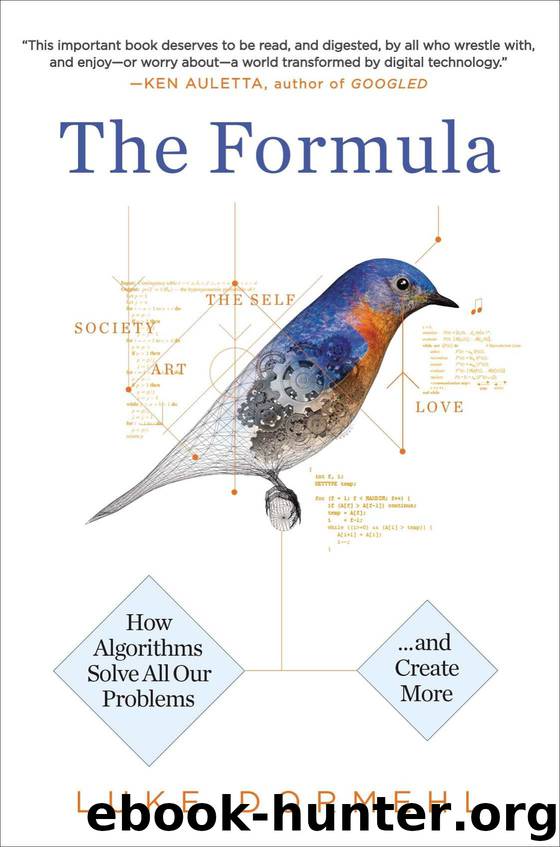The Formula: How Algorithms Solve All Our Problems-And Create More by Luke Dormehl

Author:Luke Dormehl [Dormehl, Luke]
Language: eng
Format: epub
Publisher: Penguin Group US
Published: 2014-11-04T00:00:00+00:00
The Prius and the Learning Tree
On the surface, the idea that we should be able to enforce laws by algorithm makes a lot of sense. Since legal reasoning is logical by nature, and logical operations can be automated by a computer, couldn’t codifying the legal process help make it more efficient than it already is? In this scenario, deciding legal cases would simply be a matter of entering the facts of a particular case, applying the rules to the facts, and ultimately determining the “correct” answer.
In his work, American scholar Lawrence Lessig identifies law and computer code as two sides of the same coin. Lessig refers to the laws created by Congress in Washington, D.C., as “East Coast code” and the laws that govern computer programs as “West Coast code,” in reference to the location of Silicon Valley.40 Once a law of either type is created, Lessig argues, it becomes virtual in the sense that from this point forward it has an existence independent of its original creator. Lessig was hardly the first person to explore this similarity. Three hundred years before Lessig’s birth, the great mathematician and coinventor of calculus, Gottfried Leibniz, speculated that legal liability could be determined using calculation. Toward the end of the 19th century another larger group of legal scholars formed the so-called jurimetrics movement, which argued that the “ideal system of law should draw its postulates and its legislative justification from science.”41
While both Leibniz and the jurimetrics were misguided in their imagining of the legal system as a series of static natural laws, their dream was—at its root—an honest one: based on the idea that science could be used to make the law more objective. Objectivity in a legal setting means fairness and impartiality. The person who fails to act objectively has allowed self-interest or prejudice to cloud their judgment. By attempting to turn legal reasoning into a system that would interpret rules the same way every time, the belief was that a consistency could be found to rival that which is seen in the hard sciences.
The problem with the jurimetrics’ approach to law was challenged most effectively by an experiment carried out in 2013—designed to examine the challenges of turning even the most straightforward of laws into an algorithm. For the study, 52 computer programmers were assembled and split into two groups. Each group was tasked with creating an algorithm that would issue speeding tickets to the driver of a car whenever it broke the speed limit. Both groups were provided with two datasets: the legal speed limit along a particular route, and the information about the speed of a particular vehicle (a Toyota Prius) traveling that route on a previous occasion, collected by using an on-board computer. The data showed that the Prius rarely exceeded the speed limit, and on those occasions that it did, did so only briefly and by a moderate degree. To make things more morally ambiguous, these violations occurred at times during the journey when the Prius was set to cruise control.
Download
This site does not store any files on its server. We only index and link to content provided by other sites. Please contact the content providers to delete copyright contents if any and email us, we'll remove relevant links or contents immediately.
| Algebra | Calculus |
| Combinatorics | Discrete Mathematics |
| Finite Mathematics | Fractals |
| Functional Analysis | Group Theory |
| Logic | Number Theory |
| Set Theory |
Modelling of Convective Heat and Mass Transfer in Rotating Flows by Igor V. Shevchuk(6408)
Weapons of Math Destruction by Cathy O'Neil(6220)
Factfulness: Ten Reasons We're Wrong About the World – and Why Things Are Better Than You Think by Hans Rosling(4715)
A Mind For Numbers: How to Excel at Math and Science (Even If You Flunked Algebra) by Barbara Oakley(3259)
Descartes' Error by Antonio Damasio(3249)
Factfulness_Ten Reasons We're Wrong About the World_and Why Things Are Better Than You Think by Hans Rosling(3218)
TCP IP by Todd Lammle(3157)
Fooled by Randomness: The Hidden Role of Chance in Life and in the Markets by Nassim Nicholas Taleb(3082)
Applied Predictive Modeling by Max Kuhn & Kjell Johnson(3043)
The Tyranny of Metrics by Jerry Z. Muller(3031)
The Book of Numbers by Peter Bentley(2933)
The Great Unknown by Marcus du Sautoy(2664)
Once Upon an Algorithm by Martin Erwig(2624)
Easy Algebra Step-by-Step by Sandra Luna McCune(2606)
Lady Luck by Kristen Ashley(2556)
Police Exams Prep 2018-2019 by Kaplan Test Prep(2517)
Practical Guide To Principal Component Methods in R (Multivariate Analysis Book 2) by Alboukadel Kassambara(2514)
All Things Reconsidered by Bill Thompson III(2373)
Linear Time-Invariant Systems, Behaviors and Modules by Ulrich Oberst & Martin Scheicher & Ingrid Scheicher(2348)
